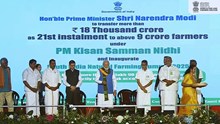
Every year, farmers in Punjab, Haryana, and Uttar Pradesh face a tough choice after harvesting their paddy crops. With little time before the next sowing season, many burn the leftover straw, called parali, to quickly clear their fields. However, this quick solution leads to significant problems. The smoke spreads across northern India, especially hitting cities like Delhi, and adds to air pollution, health issues, and climate change. It also harms the soil, making farming harder in the long run. What looks like an easy solution ends up costing us all.
But things are starting to change. New research, technology and farming practices are showing that parali isn’t just waste, it can actually be a useful resource. When managed the right way, it can help farmers earn extra income and make farming more sustainable for the future.
The Hidden Potential of Parali
India generates an estimated 500 million tons of crop residue annually, with rice and wheat straw constituting a significant portion. Traditionally, farmers burn this residue to quickly clear fields for the next crop cycle. Yet, when managed sustainably, parali can be repurposed into various economically beneficial products:
-
Biochar Production: Through pyrolysis, crop residues can be converted into biochar, a carbon-rich material that enhances soil fertility, water retention, and microbial activity, while also sequestering carbon. This not only improves crop yields but also contributes to climate change mitigation.
-
Biofuel and Energy Generation: Establishing biofuel plants that process crop waste into energy offers farmers an alternative income source and reduces the need for stubble burning.
-
Composting: Composting parali returns essential nutrients to the soil, enhancing fertility and yields. One acre can produce 2-3 tons of stubble, yielding about 1.5 tons of compost, potentially reducing chemical fertilizer use by up to 30%.
-
Livestock Feed and Mushroom Cultivation: Processed rice straw can serve as fodder for cattle or as a substrate for mushroom farming, providing additional income streams for farmers.
Innovative Technologies Leading the Way
Modern agricultural machines are playing a crucial role in changing how farmers manage stubble. The Happy Seeder allows farmers to sow wheat seeds directly into the soil without having to remove the leftover straw from the previous crop. It mixes the stubble into the soil, improving its health while also saving time and labor.
Similarly, the Super Seeder cuts and lifts the rice straw, sows the wheat seeds, and then spreads the straw back over the field as mulch. This not only prevents burning but also helps retain soil moisture and suppress weed growth.
Together, these machines reduce environmental damage, boost soil fertility, and lower farming costs, making them a smart and sustainable solution for Indian agriculture.
Startups Turning Smoke into Opportunity
Innovative startups are stepping up to turn the stubble problem into a profitable opportunity for farmers. One such example is Takachar, an MIT spin-off that has developed portable equipment to convert agricultural waste like parali into valuable products such as biofuels and biochar (a type of organic fertilizers) using a thermochemical process called torrefaction. By bringing this technology directly to the farm, Takachar helps farmers earn income from their crop residue instead of burning it, reducing air pollution and opening up new revenue streams in rural areas.
Government Support and Farmer Empowerment
To tackle stubble burning, the Department of Agriculture and Farmers Welfare launched the Crop Residue Management Scheme in 2018. It mainly supports Punjab, Haryana, Uttar Pradesh, and Delhi, offering financial aid to promote both in-situ and ex-situ solutions.
Farmers get up to 50% subsidy on machines like the Happy Seeder, Super Seeder, and Zero-Till Drill for managing stubble directly in the field. Groups like farmer cooperatives and FPOs can get up to 80% assistance to set up Custom Hiring Centres (CHCs) so that more farmers can access these machines.
For ex-situ uses like making biofuel or supplying straw to power plants, entrepreneurs and businesses can receive 65% support on machinery costs (up to Rs 1.5 crore).
According to the Department of Agriculture and Farmers Welfare, over 3.23 lakh crop residue management machines have been distributed, and more than 41,900 Custom Hiring Centres (CHCs) have been established between 2018-19 and 2024-25 (as of 28 February 2025). As a result, stubble burning incidents in key states saw a 57% reduction in 2024 compared to the previous year.
Reimagining parali as a resource rather than waste offers a dual benefit: improving farmers' livelihoods and protecting the environment. By adopting sustainable stubble management practices, leveraging innovative technologies, and supporting policy initiatives, India can transform its agricultural sector into one that is both economically viable and environmentally responsible.
















